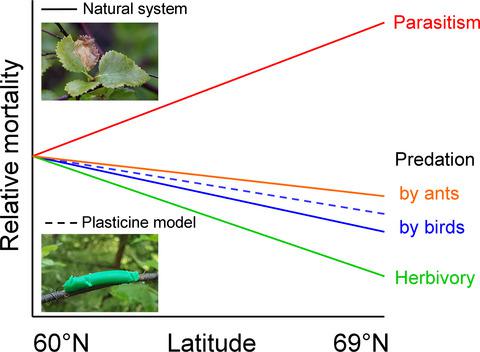当前位置:
X-MOL 学术
›
J. Anim. Ecol.
›
论文详情
Our official English website, www.x-mol.net, welcomes your feedback! (Note: you will need to create a separate account there.)
Predation and parasitism on herbivorous insects change in opposite directions in a latitudinal gradient crossing a boreal forest zone
Journal of Animal Ecology ( IF 4.8 ) Pub Date : 2020-10-09 , DOI: 10.1111/1365-2656.13350 Elena L Zvereva 1 , Vitali Zverev 1 , Mikhail V Kozlov 1
Journal of Animal Ecology ( IF 4.8 ) Pub Date : 2020-10-09 , DOI: 10.1111/1365-2656.13350 Elena L Zvereva 1 , Vitali Zverev 1 , Mikhail V Kozlov 1
Affiliation

|
The Latitudinal Biotic Interaction Hypothesis (LBIH) predicts that the strength of various biotic interactions decreases from low to high latitudes. Inconsistency between studies testing this hypothesis may result from variations among different types of interactions and among study systems. Therefore, exploration of multiple interactions within one system would help to disentangle latitudinal patterns across individual interactions and to evaluate latitudinal changes in the overall impact of enemies on prey. We tested the prediction based on the LBIH that the pressure of natural enemies on herbivorous insects decreases with increase in latitude across the boreal forest zone. We also asked whether the impacts of major groups of these enemies exhibit similar latitudinal patterns and whether these patterns are consistent across study years. In 10 forest sites located from 60°N to 69°N in Northern Europe, each summer, from 2016-2019, we measured (i) mortality of three groups of leafmining insects caused by birds, ants, parasitoids and unknown factors, (ii) bird attacks on caterpillar-shaped plasticine models, and (iii) birch foliar damage caused by defoliators and leafminers. Latitudinal patterns in both insect herbivory on birch and top-down pressure on herbivorous insects varied considerably and inconsistently among the four study years, so that only some of the year-specific correlations with latitude were statistically significant. Nevertheless, meta-analysis combining correlations across years, preys and enemies revealed general decreases in predation by birds (on both natural and model prey) and ants, but an increase in parasitism rates, from low to high latitudes. We found that the direction of latitudinal changes in the strength of biotic interactions was interaction-specific: predation and herbivory supported LBIH, whereas parasitism exhibited an opposite trend. Consequently, the overall impact of natural enemies on herbivorous insects did not change with latitude and was therefore an unlikely reason for the poleward decrease in herbivory observed in our gradient. Considerable among-year variation in the strength of the latitudinal patterns in all the studied interactions suggests that this variation is a widespread phenomenon.
中文翻译:

草食性昆虫的捕食和寄生在穿越北方森林区的纬度梯度中向相反方向变化
纬度生物相互作用假说(LBIH)预测各种生物相互作用的强度从低纬度到高纬度递减。检验这一假设的研究之间的不一致可能是由于不同类型的相互作用和研究系统之间的差异造成的。因此,探索一个系统内的多种交互将有助于理清各个交互之间的纬度模式,并评估敌人对猎物的整体影响的纬度变化。我们测试了基于 LBIH 的预测,即天敌对食草昆虫的压力随着整个北方森林区纬度的增加而降低。我们还询问了这些敌人的主要群体的影响是否表现出类似的纬度模式,以及这些模式在整个研究年份中是否一致。从 2016 年到 2019 年,每年夏天,在北欧 60°N 到 69°N 的 10 个森林地点,我们测量了(i)由鸟类、蚂蚁、寄生蜂和未知因素引起的三组采叶昆虫的死亡率,(ii ) 鸟类对毛毛虫形状的橡皮泥模型的攻击,以及 (iii) 落叶者和潜叶虫造成的桦树叶损伤。在四个研究年份中,桦树上的昆虫食草动物和食草昆虫的自上而下压力的纬度模式变化很大且不一致,因此只有一些特定年份与纬度的相关性具有统计学意义。然而,结合跨年、猎物和敌人的相关性的荟萃分析显示,鸟类(自然和模型猎物)和蚂蚁的捕食普遍减少,但寄生率从低纬度到高纬度增加。我们发现生物相互作用强度的纬度变化方向是相互作用特异性的:捕食和食草支持 LBIH,而寄生表现出相反的趋势。因此,天敌对食草昆虫的总体影响不随纬度变化,因此不太可能是在我们的梯度中观察到的食草动物向极地减少的原因。在所有研究的相互作用中,纬度模式的强度在年间变化很大,这表明这种变化是一种普遍现象。天敌对食草昆虫的总体影响不随纬度变化,因此不太可能是我们梯度中观察到的食草动物向极地减少的原因。在所有研究的相互作用中,纬度模式的强度在年间变化很大,这表明这种变化是一种普遍现象。天敌对食草昆虫的总体影响不随纬度变化,因此不太可能是我们梯度中观察到的食草动物向极地减少的原因。在所有研究的相互作用中,纬度模式的强度在年间变化很大,这表明这种变化是一种普遍现象。
更新日期:2020-10-09
中文翻译:

草食性昆虫的捕食和寄生在穿越北方森林区的纬度梯度中向相反方向变化
纬度生物相互作用假说(LBIH)预测各种生物相互作用的强度从低纬度到高纬度递减。检验这一假设的研究之间的不一致可能是由于不同类型的相互作用和研究系统之间的差异造成的。因此,探索一个系统内的多种交互将有助于理清各个交互之间的纬度模式,并评估敌人对猎物的整体影响的纬度变化。我们测试了基于 LBIH 的预测,即天敌对食草昆虫的压力随着整个北方森林区纬度的增加而降低。我们还询问了这些敌人的主要群体的影响是否表现出类似的纬度模式,以及这些模式在整个研究年份中是否一致。从 2016 年到 2019 年,每年夏天,在北欧 60°N 到 69°N 的 10 个森林地点,我们测量了(i)由鸟类、蚂蚁、寄生蜂和未知因素引起的三组采叶昆虫的死亡率,(ii ) 鸟类对毛毛虫形状的橡皮泥模型的攻击,以及 (iii) 落叶者和潜叶虫造成的桦树叶损伤。在四个研究年份中,桦树上的昆虫食草动物和食草昆虫的自上而下压力的纬度模式变化很大且不一致,因此只有一些特定年份与纬度的相关性具有统计学意义。然而,结合跨年、猎物和敌人的相关性的荟萃分析显示,鸟类(自然和模型猎物)和蚂蚁的捕食普遍减少,但寄生率从低纬度到高纬度增加。我们发现生物相互作用强度的纬度变化方向是相互作用特异性的:捕食和食草支持 LBIH,而寄生表现出相反的趋势。因此,天敌对食草昆虫的总体影响不随纬度变化,因此不太可能是在我们的梯度中观察到的食草动物向极地减少的原因。在所有研究的相互作用中,纬度模式的强度在年间变化很大,这表明这种变化是一种普遍现象。天敌对食草昆虫的总体影响不随纬度变化,因此不太可能是我们梯度中观察到的食草动物向极地减少的原因。在所有研究的相互作用中,纬度模式的强度在年间变化很大,这表明这种变化是一种普遍现象。天敌对食草昆虫的总体影响不随纬度变化,因此不太可能是我们梯度中观察到的食草动物向极地减少的原因。在所有研究的相互作用中,纬度模式的强度在年间变化很大,这表明这种变化是一种普遍现象。



























 京公网安备 11010802027423号
京公网安备 11010802027423号